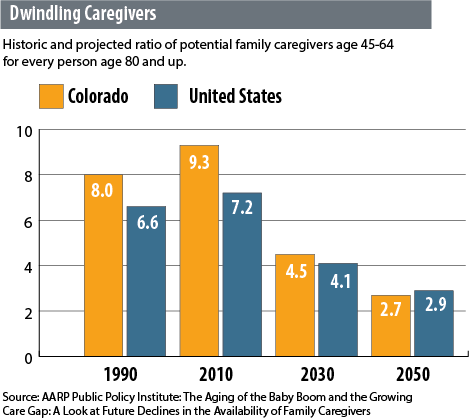The Colorado Consumer Health Initiative estimates that these family caregivers provide $6.6 billion in unpaid care each year. That’s more than a quarter of the state government’s entire 2014-15 budget.
But their work is taking its toll. About one of 10 reported that caregiving caused their physical health to decline. One study conducted by the American Psychological Association (APA) found that stress hormones in caregivers are 23 percent higher than in non-caregivers, and that their antibody responses are 15 percent lower. The APA also found that caregivers are less likely to actually address their health issues than non-caregivers.
So, while family caregivers are playing a vital role in the health care system, they may be worsening their health, potentially increasing health care costs in the future.
Meanwhile, the need for these unofficial caregivers is expected to grow even as the ranks of available caregivers dwindle.
The number of people over age 65 in Colorado is expected to triple by 2040, growing twice as fast as the total population, according to the State Demography Office. This is often referred to as the Silver Tsunami. But as Baby Boomers continue to age, they will move out of their peak caregiving years. Add to this smaller family sizes and more working couples, and the number of available caregivers in Colorado for high risk years is expected to decline by nearly half by 2030.
So while more people than ever will be seeking care, particularly long-term services and supports (LTSS), there most likely will be fewer people available to provide that care. This will require new policies and efforts in Colorado, which is already struggling to maintain enough health care professionals for all residents, especially those in rural and mountain areas.
Policymakers and advocates who are focused on providing adequate LTSS services in the future will be considering how to meet increased demand while keeping costs in check. In Colorado, this work has begun. The state is working to coordinate the health care of people who are dually enrolled in both Medicare and Medicaid. It is also trying to create a “No Wrong Door” system that makes it easier for people to enroll in LTSS programs.

